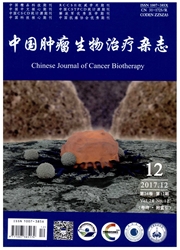

 中文摘要:
中文摘要:
目的:探讨TLR4信号对乳腺癌4T1细胞株中miR-21表达的影响及调控机制,研究miR-21对乳腺癌细胞凋亡和增殖的影响。方法:体外培养乳腺癌细胞株4T1,以TLR4配体LPS刺激6、12、18、24 h,实时荧光定量PCR检测4T1细胞中miR-21的表达变化。Western blotting 检测TLR4信号活化后4T1细胞中NF-κBp65的表达和磷酸化情况;应用NF-κB抑制剂PDTC预处理30 min,实时荧光定量PCR检测4T1细胞中miR-21的变化。转染miR-21抑制剂和阴性对照后, Annexin-V/PI双标法检测4T1细胞凋亡情况,MTT法检测4T1细胞增殖情况。结果:LPS刺激致TLR4信号活化能够时间依赖性地上调miR-21的表达(18 h时: 2.07±0.33 vs 1; t=5.61, P=0.03),TLR4信号能够时间依赖性地上调NF-κB的活化,NF-κB抑制剂PDTC能明显抑制TLR4信号诱导的4T1细胞的miR-21上调(0.70±0.10 vs 2.14±0.32; t=-7.357,P=0.002)。与阴性对照组相比,miR-21抑制剂组4T1细胞的凋亡率明显增高[(24.2±2.4)% vs (14.8±5.1)%; t=2.891, P=0.044],4T1细胞的增殖能力明显降低(0.42±0.02 vs 0.55±0.01;t=-8.528, P=0.001)。结论:TLR4信号通路的活化能够上调乳腺癌4T1细胞中miR-21的表达,其机制与NF-κB的活化有关;靶向抑制miR-21能有效促进4T1细胞的凋亡、抑制4T1细胞增殖。
 英文摘要:
英文摘要:
Objective:To investigate the effect of TLR4 signaling on breast cancer cell proliferation/apoptosis and the underlying mechanism in vitro.Methods: Breast carcinoma 4TI cells were stimulated with 100 ng/ml lipopolysaccharide (LPS) after a preincubation with DMSO or NF-κB inhibitor PDTC for 30 min. At 6, 12, 18 and 24 h after LPS stimulation, levels of miR-21 were measured by qRT-PCR, phospho-NF-κBp65 was determined by Western blotting analysis. Apoptosis and cell viability in 4T1 cells transfected with mock (control) or an miR-21/inhibitor were assessed by Annexin-V/PI staining and MTT assay,respectively. Results: LPS induced significant increasement of miR-21 level and NF-κB activation in 4T1 cells in a time-dependent manner (18 h: 2.07±0.33 vs 1; t=5.61, P=0.03), which were significantly attenuated by NF-κB inhibitor PDTC. Transfection of 4T1 cells with miR21 inhibitor resulted in a significant increase in apoptosis (0.70±0.10 vs 2.14±0.32; t=-7.357,P=0.002) and a significant decrease in cell growth (0.42±0.02 vs 0.55±0.01;t=-8.528, P=0.001), as compared with transfection with mock. Conclusion: Activation of TLR4 signaling pathways may up-regulate miR-21 through NF-κB activation in breast carcinoma 4T1 cells. Targeted inhibition of miR-21with a sequence-specific inhibitor can effectively induce apoptosis and suppress 4T1 cell growth, thus having a great potential in the treatment of breast carcinoma.
 同期刊论文项目
同期刊论文项目
 同项目期刊论文
同项目期刊论文
 期刊信息
期刊信息
